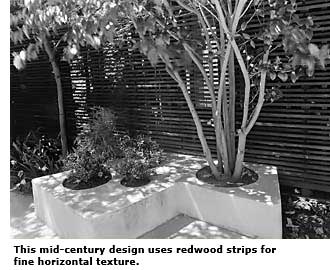Great Garden Walls - Page 2
While functional, this basic approach to fencing does not make the most of the design opportunity or significantly enhance the character of the modern garden. Varying fence height, materials, and location can make all the difference—adding a dynamic quality to what might otherwise be a basic box of space.
Height determination is one of the most important design decisions when planning a new fence. The six-foot standard is a good starting point for any design, but before a final fence height is determined, additional factors such as the sightlines required for maintaining privacy and outward views should be considered.
"On some projects, we intentionally keep the fencing low to allow for more expansive views," says Garcia. "In another situation, where the house might be located much closer to the neighbors, the fences are built high as possible. In both projects, the fence height responds to the design changes within the house, where we are opening up rooms and improving views to the outside. In the first case, we want to extend that view all the way to the distant landscape, in the second we use the fencing to ensure that the interior of the house has adequate privacy."
The walls of the outdoor room require a different scale than those inside the house. Indoors, the line of sight typically focuses on objects at or below the six-foot level, making the furnishings and floor more readily noticeable than the ceiling. In the garden, the eye is more likely to be drawn upward, towards the sky, rather than to the ground, so the six-foot level is perceived differently outdoors.
Obviously, the height of a standard property-line fence does not effectively block the sightlines to adjacent buildings or from uphill neighbors; so supplemental planting of hedges or trees that are not governed by height restrictions is often needed to ensure privacy.

Local ordinances should always be consulted before finalizing a design. However, it should be noted that the height of garden structures—a screen or trellis, for example—that is set beyond the property line setback is not necessarily subject to the six-foot restriction. In such cases, it might be possible to achieve a greater degree of privacy or visual screening by extending the line of a building wall into the landscape at a height of eight feet or more.
The orientation of the house on the lot and the proximity of other homes are two of the factors that David Thimgan considers when determining an appropriate fence height.
"Fencing should always be tall enough to provide the security and privacy desired by the homeowner, but care should be taken not to wall off the lot," Thimgan says. "The design of a fence can allow for openings, or can use transparent or translucent materials that allow views out or natural light in to the enclosed space. This is especially important for side yards where homes are often placed quite close together."
In situations where views are more important than privacy, a fence lower than six feet high is worth considering. For seated conversation, a sightline of four feet typically provides an adequate sense of privacy without interrupting a view outward.
What fence materials work
best for your modern home?
Just as the walls of the house are not made up of a single material, the walls of the outdoor room need not be all the same. Mixing materials adds interest the design and also allows the fence to respond to the different conditions that might exist on the property.
1 WOOD Flexibility of design and construction, availability, and low cost are three reasons why wood is the most popular choice in fencing material. However, it is worth noting that wood must be maintained to retain its good looks, and this factor leads to the design decision of painting or staining the fence.
Many of the woods typically used in fencing weather nicely. Redwood, cedar, teak, and ipe all achieve a soft gray patina if left untreated. While this is not an unattractive look, it might be too rustic for an otherwise crisply detailed modern garden.
The alternative to the natural look is a painted fence. The design opportunities offered by painting are endless, but so is the maintenance obligation. When making the decision to paint a fence or garden structure, it is important to keep in mind that it will have to be repainted periodically to retain that sharp look.
2 BAMBOO
Fences made of bamboo are seen with increasing frequency in the modern garden. There are a number of qualities that make it an option worth considering. As a fast-growing renewable material, bamboo is an environmentally friendly material, and many bamboo products are manufactured using free trade practices that ensure harvesters are treated fairly.




